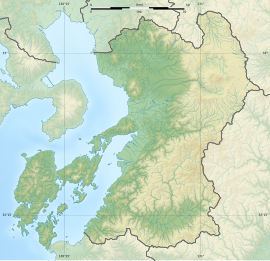| 石貫穴観音横穴 | |
  | |
| Location | Tamana, Kumamoto, Japan |
|---|---|
| Region | Kyushu |
| Coordinates | 32°58′09″N 130°33′47″E / 32.96917°N 130.56306°E / 32.96917; 130.56306 |
| Type | corridor-type kofun [ja] (横穴式石室, yokoana-shiki sekishitsu) |
| Site notes | |
| Public access | Yes |
| National Historic Site of Japan | |
The Ishinuki Anakannon Cave Tombs (石貫穴観音横穴, Ishinuki Anakannon yokoana) is an archaeological site containing five Kofun period Corridor-type kofun [ja] (横穴式石室, yokoana-shiki sekishitsu) located in the Ishinuki neighborhood of the city of Tamana, Kumamoto, Japan. It was granted protection as a National Historic Site in 1921.
Overview
The Ishinuki Anakannon Cave Tomb is located about 5 kilometers north from the urban center of Tamana, just past Toratori Bridge over the Hanegi River. The cluster consists of five large corridor-type kofun on the west side of the same hill as the Ishinuki Cave Tomb Cluster, which has a separate National Historic Site designation. Tombs 1 to 3 are lined up in a row, and Tombs 4 and 5 are slightly further apart and lower. The first three tombs are decorated kofun, and have triple-layered decorative borders at the entrance, with the outer two arched, and a faint red circle pattern. The central tomb has a carving of the Senjū Kannon (Sahasrabhuja) in the inner chamber, and an Jūichimen Kannon to the right, so it is called the "Ana Kannon" (hole Kannon). This tomb consists of an antechamber and an inner chamber, the antechamber is almost square, 2.5 by 2.9 meters. The entrance to the inner chamber is covered with real tiles. The Thousand-Armed Kannon faith was introduced in the Nara period, and the cave may have to have been built in the first half of the 8th century, rather than having been a re-purposed Kofun period tomb.
See also
References
- "石貫穴観音横穴". Cultural Heritage Online (in Japanese). Agency for Cultural Affairs. Retrieved 5 December 2023.
- Isomura, Yukio; Sakai, Hideya (2012). (国指定史跡事典) National Historic Site Encyclopedia. 学生社. ISBN 4311750404.(in Japanese)
External links
- Tamana City home page (in Japanese)